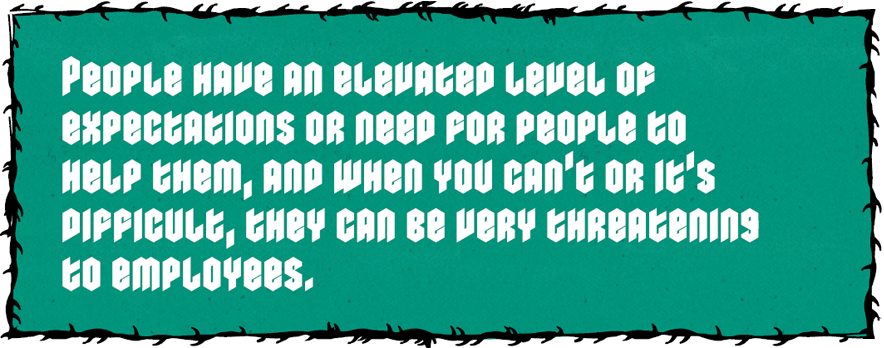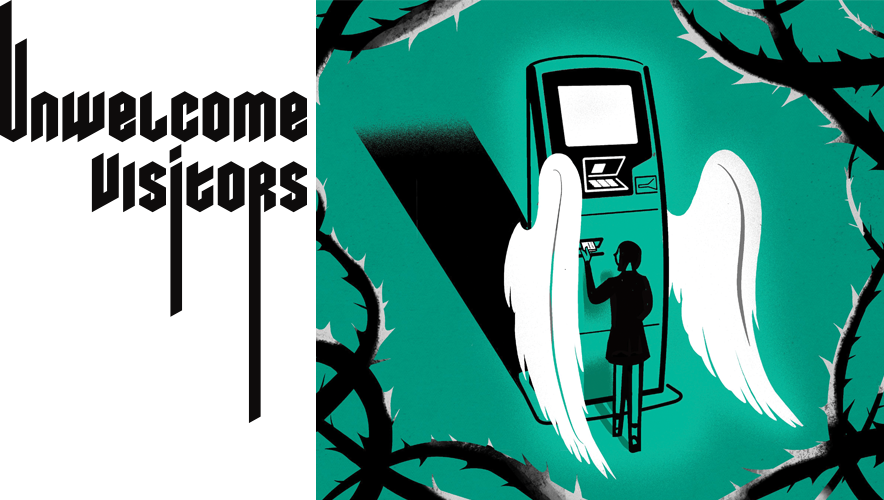Coping with Vagrancy in ATM Vestibules
When was the last time you went to a bank? Compare that to how often you use mobile banking apps or remote services. The nature of banking has changed—a shift only accelerated by closures during the COVID-19 pandemic—and the nature of crime at bank branches has changed along with it.
“The risks are lower today than they were 25 years ago, just because people aren’t banking the way they were 25 years ago,” says Omar Valdemar, CPP, vice president and corporate security systems team manager for City National Bank. Financial services are being conducted more frequently on smartphones than in branches, which reduces foot traffic at banking locations and at ATMs.
“But the problem we are seeing of unwanted visitors, of vagrants—we are seeing an increase,” he says. “I think this is a social problem we’re having in our communities right now… (homeless people on private property) seem to be a little bit bolder, some don’t care, and they do whatever they want. And we’ve seen more incidents lately across financial institutions.”
Homelessness in the United States has been on the rise for years. According to a nationwide survey conducted by the U.S. Department of Housing and Urban Development (HUD), approximately 580,000 people were homeless at the beginning of 2020—an increase of nearly 15,000 people from 2018. More than 60 percent were staying in sheltered locations, such as emergency shelters or transitional housing programs, but 39 percent were in unsheltered locations, including living on the street, in abandoned buildings, or other locations.
No official numbers yet exist about how the COVID-19 pandemic and related economic factors have affected homelessness, but according to May 2020 analysis conducted by Columbia University Economics Professor Brendan O’Flaherty, the United States could see a 40 to 45 percent jump in homelessness as a result of the COVID-19 pandemic and subsequent unemployment and evictions.

This is no surprise to banking security professionals, many of whom have noted a significant increase in the number of trespassing incidents in branches, particularly where enclosed shelters such as ATM vestibules are open to users after business hours.
Richard Mercuri, CPP, corporate security director for a northeastern U.S. bank and a member of the ASIS Banking and Financial Services Community Steering Committee, tells Security Management that the number of homeless people who had to be removed from ATM vestibules in his organization’s network tripled over the past two years.
While it is not unusual for homeless people to use ATM vestibules to escape bad weather, especially in urban areas, the number of cases and the heightened likelihood of conflict has made the issue more challenging for security professionals, who are applying myriad tools and tactics to ensure employees and customers remain safe and the bank stays open for business.
“It’s always been an issue, ever since ATM vestibules started being used,” Mercuri says. “But in recent years, the issue seems to have gotten worse, and less related to weather than from a lack of other places to go.”
Particularly during the start of COVID-19, when public spaces such as New York City subway stations were closed at night for deep cleaning, homeless people have been in search of places to shelter at night or during severe weather.
When large numbers of businesses temporarily closed during the start of the pandemic, homeless people made use of their unused entryways, alleys, and other property to take shelter. But as those businesses reopen to the public, some people have been unwilling to vacate an area that they called home for months. The rising number of overall incidents with homeless people has been accompanied by a rise in conflict and malicious incidents.
“From a safety standpoint, in the homeless community there is a vast array of individuals, including some with various types of problems, whether it be mental illness or drug addiction, and oftentimes their behavior is very unpredictable,” Mercuri says. “Over the past two years, we have seen an increase of aggressiveness of this population within the vestibules. They are less willing to leave when asked to leave by branch staff or security staff, we have had numerous incidents with violence when they would physically assault those that are trying to get them to leave, and we have also seen an uptick in the amount of damage that’s being caused in the vestibules.”
In retaliation for being removed from ATM vestibules where they were sheltering or sleeping, people have defaced facilities with trash and bodily waste, set fires, pulled down ceilings, and otherwise damaged bank property, Mercuri says.
Along with a workplace violence threat, this poses a health and safety risk for customers and employees, he adds, and for banks with ATM vestibules that become part of the entryway to the bank branch during business hours, a damaged or dirty vestibule means that the branch must delay its opening until a specialized cleaning crew can sanitize the area.
Employee Education
Banks are one of the only businesses in the world that expects to be robbed multiple times per year, but conflict cannot become a “normal” state of affairs, says Stephanie Clarke, senior vice president and director of physical security solutions for KeyBank.
ATM vestibules are not the only site of conflict—altercations and abuse are becoming more common as customers feel increasing financial pressure from the fallout of COVID-19 economic dips and increased fraud, Clarke says, adding that banks are often trapped in the middle of these financial frustrations. Especially since the start of the COVID-19 pandemic, she has noticed a spike in customers’ anger due to delays in receiving unemployment benefits, overdraft fees, or fraud holds on checking accounts.
“People have an elevated level of expectations or need for people to help them,” Clarke says. “And when you can’t or it’s difficult, they can be very threatening to employees. Between that and a rise in vagrancy, that’s all contributing to a rise in threats to our people and property.”
This has resulted in an uptick in violent threats against employees across all facets of the financial institution, from bank branches to call centers, social media, and mobile banking platforms, she says, as well as confrontations from people seeking to loiter on or otherwise use bank property.
“We are tracking everything now, and we’re getting more detailed on the factors and methods so we can really drill down and have more impact with our reporting,” Clarke says. “So often when you have branches that are in high-crime areas or areas that are affected the most by certain activity, it can start to feel like normal business. But we have to know about it, because if we don’t know about it, we won’t know to put different measures in place that could make it safer.”
Understanding the rate of incidents and any emerging trends can help security leaders adjust resources, training, and protocols to match each location’s needs, such as adding patrols or surveillance cameras to help deter or detect potential threats.

Banks’ experience with robberies means that resources are often already in place to help support employees who experience an altercation. But expanding and communicating regularly about employee assistance programs (EAPs) and other resources to address escalating conflicts, verbal harassment, and loitering can soothe employees’ and their families’ anxieties about the job, says Brian Ishikawa, CPP, senior vice president and director of corporate security for the Bank of Hawaii Corporation.
“We have to make not only our employees safe and comfortable, but we have to watch that perception of security,” he says.
Regarding managing homeless people on bank property, employee reactions and impulses are often mixed.
“Our colleagues are being hyper-sensitive of ‘Do we tell these people to leave or not?’” Valdemar says. While some employees feel like they should leave homeless people be, especially in inclement weather such as heat waves, others would prefer to remove them from bank property quickly. Providing multiple options for next steps enables employees to select the course of action that will be safest and most fitting for the situation.
Banks can bolster their training regimens, adding in de-escalation tactics and guidance for managing irate customers, loiterers, or other unwanted visitors, Ishikawa says. Especially given variable response times from law enforcement and other first responders to non-emergency calls such as trespassing without any immediate threat, bank employees and private security may need to manage a situation for an hour or more. Law enforcement resources are stretched thin, he adds, and providing guidance on how to respond to or defuse a dicey situation reassures employees and security personnel.
The Bank of Hawaii has also worked with local social organizations—such as government groups, nonprofits, and social workers—to manage outreach to the local population of homeless people to find non-punitive solutions to loitering problems, Ishikawa says.
Physical Security Measures
Guard patrols can serve as an excellent deterrent and response tool, but when trying to manage people using bank property as a camp, patrols turn into a cat and mouse game, Ishikawa says. Homeless people see guards coming or keep track of patrol schedules and move on temporarily, waiting until guards finish their rounds to return.
The greatest tool available to help banks address loitering risks is surveillance, Valdemar says. It enables early detection of potential loitering or vandalism, kickstarting the process of requesting security or police response. Additional technology can be layered on top of surveillance cameras to bolster protection and remote response.
For instance, he says bank branches with ATM vestibules could configure motion detection-based surveillance to trigger an alarm if a person has been in the vestibule for longer than the average transaction time. A remote monitor or guard could assess the video and use an audio speaker in the vestibule to ask if the customer needs assistance or to direct a loiterer to leave.
“They can start a conversation, do an assessment, and make a determination if law enforcement needs to be dispatched,” Valdemar says.
Access control measures can also be leveraged—bank branches can lock down vestibules after business hours, but customers who have an ATM-enabled credit card can use it to gain access to the vestibule.
Ishikawa and his team are taking technological solutions a step further by exploring the use of ground-based drones and robotics on Bank of Hawaii properties. For locations that could benefit from a 24/7 guard presence, a robot makes more financial sense than adding a guard post, Ishikawa says, and robots offer additional security solutions that can make them ideal for detecting and responding to homeless people or loiterers—particularly after dark.

Robotic patrols can feature thermal cameras, which can detect people hiding in shrubbery or landscaping, and they are constantly recording video that can be used in investigations or threat assessments. Additionally, some robots can detect Wi-Fi connection signatures from cell phones, so if a trespasser keeps returning to a bank branch to use its Wi-Fi at night, the robot could note the recurring signature, Ishikawa says.
Ishikawa has also partnered with other local banks to share information and develop dossiers on repeat offenders to share with law enforcement when they arrive. This makes it clear to law enforcement that the incidents are not isolated, but part of a continuing pattern, which requires a different response.
Beyond response and detection, deterring unwanted behavior in the first place may require an investment in design.
CPTED
Crime prevention through environmental design (CPTED) influences human behavior and minimizes unintentional conflict, says Mark Schreiber, CPP, president and principal consultant for Safeguards Consulting, Inc. While the principles of CPTED won’t stop a motivated intruder, they can subtly signal to a visitor which areas are public, which are private, and what behavior is appropriate.
Some common CPTED measures include trimming back trees and shrubs to reduce barriers to surveillance camera views and eliminate places for people to hide or sleep. Organizations can also replace benches with subdivided seating, so comfortable resting areas are still provided but it is difficult to lie down across the bench. If people experiencing homelessness start camping out on grass or greenspace around the property, organizations could install statues, planters, or boulders to make that area less open.
Above and beyond basic security measures, there are three CPTED elements that can be particularly valuable when addressing a rise in vagrancy or trespassing, Schreiber says.
Territorial reinforcement. When a visitor crosses onto a bank’s premises, the organization can emphasize the departure from public to private property in several ways, including using a different texture or color of pavement, providing clear signage, and leveraging landscaping or fencing to form barriers. Even short barriers such as hedges or knee-high walls reinforce the notion that a space is off-limits.
“It gives a very clear understanding that someone has exited the public space and entered a private space where public rules and laws don’t necessarily apply—the owner of that private space has the authority to allow or disallow any activity within that space according to their legal rights,” Schreiber says.
Natural access control. “This means controlling the environment itself so that anyone who is entering or accessing this space takes the routes that we want them to take instead of wandering around and accessing space we don’t want them to access,” Schreiber says.
Designing these pathways enables security to quickly identify people who are not following the rules or routes as intended, which allows security to more quickly respond to unauthorized activity.
Fundamentals of natural surveillance. This allows personnel and staff to immediately observe behavior on the property at a glance, reducing hiding places and enabling quick, proactive responses.
To reduce customers’ frustrations before they get to the teller window, Schreiber says banks should minimize bad design, such as circuitous routes through hallways or multiple barriers to reach the destination, which can put visitors in a bad mood from the start while potentially blocking egress routes or surveillance views.
Banks can also use positive activity generators to reinforce desired behavior. For instance, they can build a welcoming and amenity-filled waiting area for customers in a well-monitored area far away from any restricted-access offices. By reducing the need for customers to pass by a high-security or sensitive region, it becomes easier to spot anomalies and respond if someone is behaving unusually.
Where ATM vestibules are concerned, Schreiber says CPTED measures should focus on making the amenity a place of business, not a comfort station. That means designing the space to be small—too small to comfortably lay down in—and investing in good lighting and vandal-resistant materials.
“If it looks like its been vandalized, it’s likely more crime will happen there,” Valdemar says. “Our colleagues are really good about inspecting our ATMs anyway when looking for skimming devices, so it’s an opportunity to assess not just the ATM but the vestibule for any issues.”
Claire Meyer is managing editor of Security Management. Connect with her via email at [email protected] or on LinkedIn.






